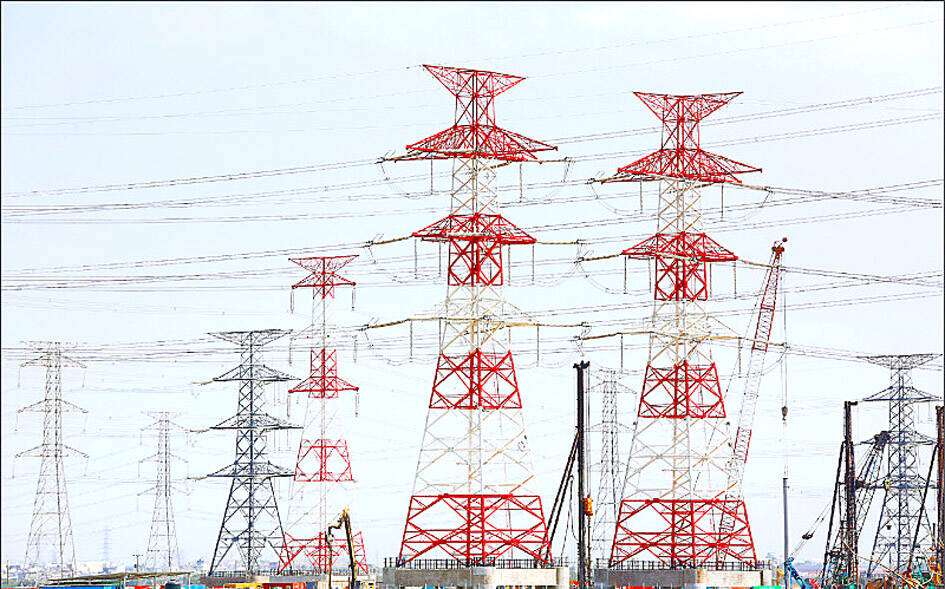Power consumption rises 1.27% last month: institute – Taipei Times

Economic Performance and Sustainable Development in Taiwan: An Analysis of Industrial Electricity Consumption
Executive Summary
A recent analysis of Taiwan’s electricity consumption, based on the Electricity Prosperity Index (EPI) from the Taiwan Research Institute, indicates continued economic growth driven primarily by the high-technology sector. However, a significant divergence in performance between technology-focused and traditional industries presents challenges and opportunities related to the nation’s progress toward key Sustainable Development Goals (SDGs), particularly SDG 7, SDG 8, SDG 9, and SDG 12.
Overall Economic Health and Industrial Performance
The EPI report highlights a bifurcated economic landscape where industrial performance is increasingly divided.
- The overall EPI rose by 1.27 percent year-on-year, signaling a “yellow-red” light for the third consecutive month.
- The national economy is projected to have expanded by 4.1 percent last month and 3.8 percent in the third quarter, largely due to strong export orders and the performance of the semiconductor industry.
- Overall high-voltage power usage increased by 2.11 percent, with the manufacturing sector rising 1.97 percent and the service sector growing 2.25 percent.
Analysis of Sectoral Performance and SDG 9: Industry, Innovation, and Infrastructure
The data reveals a stark contrast between industries, underscoring the challenges of achieving the inclusive and sustainable industrialization targeted by SDG 9.
- Innovation-Driven Growth: The technology sector, fueled by global demand for Artificial Intelligence (AI) and high-performance computing, shows robust growth.
- Semiconductors: Electricity consumption increased by 8.47 percent year-on-year, registering a “red” light for the sixth straight month.
- Computers, Electronics, and Optical Products: Power usage grew by 8.04 percent, also indicating a “red” light.
- Challenges in Traditional Industries: Traditional sectors face declining demand, indicating a need for structural transformation and investment in sustainable industrial practices.
- Steel Products: Consumption fell by 6.35 percent due to US tariffs and weak demand.
- Textile Firms: A significant decline of 12.31 percent was recorded.
- Chemical Materials: Power usage decreased by 3.59 percent amidst global overcapacity.
- Machinery Equipment: Consumption was down 5.38 percent.
Implications for SDG 7 (Affordable and Clean Energy) and SDG 12 (Responsible Consumption and Production)
The high energy consumption of the booming technology sector places a significant focus on sustainable energy and production patterns.
- The substantial energy demand from semiconductor and electronics manufacturing highlights the critical need to align industrial policy with SDG 7, emphasizing energy efficiency and accelerating the transition to clean, renewable energy sources to power this growth sustainably.
- This trend presents a challenge for SDG 12, as it necessitates the development of responsible production models that decouple economic prosperity from energy-intensive resource consumption.
Economic Outlook and Alignment with SDG 8: Decent Work and Economic Growth
The future economic trajectory depends on balancing high-tech growth with the revitalization of traditional sectors to ensure inclusive and sustainable progress as outlined in SDG 8.
- The continued strength of the AI-driven technology sector is expected to support near-term economic growth.
- However, the report explicitly warns that the challenges facing traditional industries require urgent attention.
- To achieve the long-term, inclusive economic growth envisioned by SDG 8, strategic focus must be placed on the transformation and upgrading of these industries. This ensures a just transition, protects employment, and fosters a more resilient and balanced national economy.
Analysis of the Article in Relation to Sustainable Development Goals
1. Which SDGs are addressed or connected to the issues highlighted in the article?
-
SDG 8: Decent Work and Economic Growth
- The article is fundamentally about economic performance and growth. It discusses Taiwan’s overall economic expansion, citing projected growth rates of 4.1% and 3.8%. It also analyzes the health of different economic sectors, which is central to sustainable and inclusive economic growth.
-
SDG 9: Industry, Innovation and Infrastructure
- The article highlights the critical role of innovation and technology in driving economic activity. The “artificial intelligence [AI] boom” and thriving demand for “high-performance computing, cloud services, and information and communications technology” are shown as key drivers for the semiconductor and electronics industries. It also points to the challenges of “structural transformation” and upgrading for traditional industries, which is a core theme of SDG 9.
-
SDG 7: Affordable and Clean Energy
- While the article does not discuss the affordability or cleanliness of the energy, it uses electricity consumption as its primary metric for gauging economic activity. The detailed breakdown of power consumption by various industries directly relates to energy use patterns, which is a component of SDG 7. The analysis of consumption trends is a prerequisite for developing energy efficiency strategies.
2. What specific targets under those SDGs can be identified based on the article’s content?
-
Under SDG 8: Decent Work and Economic Growth
- Target 8.1: “Sustain per capita economic growth in accordance with national circumstances and, in particular, at least 7 per cent gross domestic product growth per annum in the least developed countries.” The article directly addresses this by reporting that “the economy likely expanded 4.1 percent year-on-year last month and 3.8 percent in the third quarter,” providing a measure of national economic growth.
- Target 8.2: “Achieve higher levels of economic productivity through diversification, technological upgrading and innovation, including through a focus on high-value added and labour-intensive sectors.” The article exemplifies this target by contrasting the high-growth, innovative semiconductor and electronics industries (driven by AI) with the declining traditional industries that face “challenges of structural transformation.” This highlights the disparity in economic productivity and the need for technological upgrading across the economy.
-
Under SDG 9: Industry, Innovation and Infrastructure
- Target 9.2: “Promote inclusive and sustainable industrialization and, by 2030, significantly raise industry’s share of employment and gross domestic product, in line with national circumstances, and double its share in least developed countries.” The article’s core theme is the state of industrialization, showing a non-inclusive pattern where high-tech sectors are booming while traditional industries see a “continuous decline in electricity demand and a sluggish outlook.”
- Target 9.5: “Enhance scientific research, upgrade the technological capabilities of industrial sectors in all countries…” The success of the semiconductor and electronics industries, bolstered by the “AI boom” and demand for “high-performance computing,” directly reflects advanced technological capabilities and innovation within these sectors.
3. Are there any indicators mentioned or implied in the article that can be used to measure progress towards the identified targets?
-
Indicators for SDG 8 Targets:
- For Target 8.1, the article provides a direct measure related to Indicator 8.1.1 (Annual growth rate of real GDP per capita). The stated economic expansion rates of 4.1% and 3.8% serve as a proxy for this indicator.
- For Target 8.2, the article provides proxy indicators for economic productivity by sector. The disparity in electricity consumption growth rates serves as a measure of this: +8.47% for semiconductor firms and +8.04% for electronics suppliers, versus -3.59% for chemical producers, -6.35% for steel suppliers, and -12.31% for textile firms. This data quantifies the gap in productivity and technological adoption.
-
Indicators for SDG 9 Targets:
- For Target 9.2, an indicator of industrialization health is the “Electricity Prosperity Index (EPI),” which rose 1.27%. More specifically, the demand from the manufacturing sector rose 1.97%. The breakdown of these figures reveals the non-inclusive nature of this growth.
- For Target 9.5, the article implies strong performance through qualitative and quantitative indicators. The “booming ‘red’ light for the sixth straight month” for the semiconductor industry’s electricity activity index is a specific, albeit proprietary, indicator of high technological activity. The high growth in electricity consumption (+8.47%) in this sector is a quantitative measure of the output from this innovation.
-
Indicators for SDG 7 Targets:
- Related to Target 7.3 (Improve energy efficiency), the article provides detailed energy consumption data that is a necessary first step for measuring efficiency. The specific indicators are the percentage changes in electricity use by industry, such as the 2.11% increase in overall high-voltage power use and the specific figures for manufacturing (+1.97%) and services (+2.25%).
4. Table of SDGs, Targets, and Indicators
| SDGs | Targets | Indicators |
|---|---|---|
| SDG 8: Decent Work and Economic Growth |
8.1: Sustain per capita economic growth.
8.2: Achieve higher levels of economic productivity through diversification and technological upgrading. |
– Projected economic expansion: 4.1% and 3.8%.
– Sectoral electricity consumption growth as a proxy for productivity:
|
| SDG 9: Industry, Innovation and Infrastructure |
9.2: Promote inclusive and sustainable industrialization.
9.5: Upgrade the technological capabilities of industrial sectors. |
– Electricity Prosperity Index (EPI) growth: +1.27%. – Manufacturing sector electricity demand growth: +1.97%. – Semiconductor industry’s electricity activity index showing a “booming ‘red’ light.” |
| SDG 7: Affordable and Clean Energy | 7.3: Double the global rate of improvement in energy efficiency. |
– Overall high-voltage power use increase: +2.11%. – Service sector electricity demand growth: +2.25%. – (These figures on energy consumption are foundational for calculating energy efficiency.) |
Source: taipeitimes.com
What is Your Reaction?
 Like
0
Like
0
 Dislike
0
Dislike
0
 Love
0
Love
0
 Funny
0
Funny
0
 Angry
0
Angry
0
 Sad
0
Sad
0
 Wow
0
Wow
0














































/environment-climate-change-and-health-(ech)/water-sanitation-hygiene-and-health-(wsh)/landfill-tuvalu-36092.tmb-1200v.jpg?sfvrsn=5c21fe40_1#)



.jpg.webp?itok=0ZsAnae9#)























